Cannes, France, March 27th - April 5th, 1910
The start of the 1910 European season: Rookies shine on the Riviera!

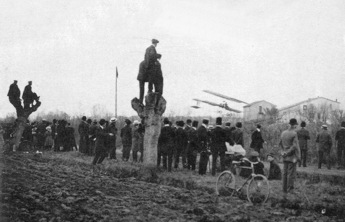

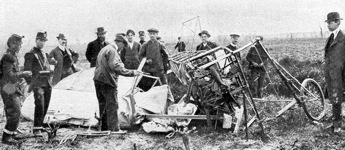
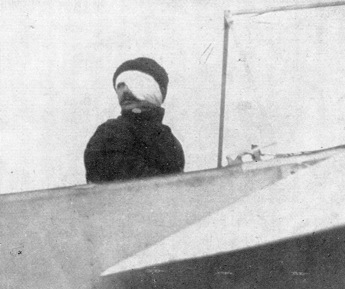
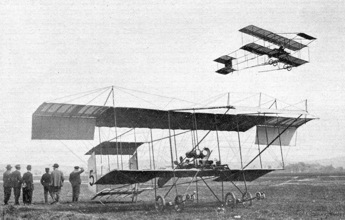
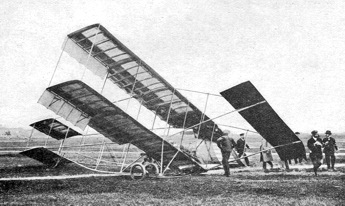

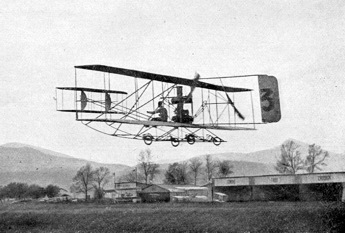






Cannes is a town in Provence in southern France. Its
position on the sunny Côte d'Azur has always ensured
its status as a resort for the rich and famous. In 1910
it had a population of around 30,000 inhabitants, with
10,000 visitors coming every year to enjoy the mild
winter climate. Apart from tourism, the main sources of
income were agriculture, for example production of
olives, fruit, perfume and soap, and fishing.
Cannes already had an aviation tradition. Ferdinand
Ferber had made glider flights there already in 1901 and
early in 1909 the French Wright licensees Ariel had
established a flying school in order to be able to fly
during the winter. During the autumn of 1909 around 80
towns applied for sanction from the Aéro-Club de France
to hold an aviation meeting. Cannes was one the lucky
towns that were granted a sanction.
The meeting was organized by the "Comité
d'Aviation de Cannes" together with the
Aéro-Club de Cannes. The competitions were of course held
according to FAI regulations. According to new rules
decided by the Aéro-Club only pilots with a valid
"brevet de pilote" were allowed, no doubt as a
consequence of the highly publicized incidents and
accidents involving novice pilots at the October 1909
Port-Aviation meeting.
Originally there were 17 entrants:
- Marcel Baratoux (Wright)
- "Braun" (Gregoire-Gyp)
- Joseph Christiaens (Farman-Gnôme)
- André Crochon (Farman-Gnôme)
- "De Virel" (Gregoire-Gyp)
- Fernand Deletang (Blériot-Anzani)
- Alfred Frey (Farman-Gnôme)
- Louis Gaubert (Wright)
- René Hanriot (Hanriot-Darracq)
- Henri Jullerot (Farman-Gnôme)
- Léon Molon (Blériot-Anzani)
- Edmond Morelle / "Edmond" (Farman-Renault)
- Victor Rigal (Voisin-Darracq)
- Hayden Sands (Antoinette)
- Frederick van Riemsdijk (Curtiss)
- Louis Wagner (Hanriot-Darracq)
- Vincent Wiesenbach (Wright)
Deletang, Jullerot and the Grégoire and Hanriot teams
never turned up. On the other hand Nicolas Popoff and
Paul Bablot on Wrights were added to the list. This was
the first meeting for most of the pilots. Baratoux had
qualified for his license immediately before and Gaubert,
Popoff and Wiesenbach planned to qualify during the
meeting.
The total prize money was 70,000 francs. The main event
was the 25,000 francs "Prix du Voyage", a race
from the airfield, across the Golfe de la Napoule, around
the "Butte de Tir" on the island Île
Sainte-Marguerite, around the Pointe de la Croisette in
Cannes and back. Apart from the short cross-country race
at the Vichy meeting the summer before it was the first
of its type.
The meeting started during the Easter weekend. The Wright
team was in place long before the meeting and Popoff had
already made several long flights, even though the flyers
complained of people making their way onto the course.
Molon had prepared carefully, flying during 24 days of
the month of December in his home town Le Havre.
Sunday March 27th
The first day of the meeting attracted 40,000 visitors
and was quite justifiably hailed as an enormous success
by the ecstatic local press. The official start of the
meeting was at ten o'clock and from then to the end
of the day at six o'clock there was constant action
on the field and in the air. Eight planes made flights
and the total time of the official flights was more than
seven hours. Frey on his Farman was in the air for almost
three hours, while Crochon made the longest non-stop
flight of 1 h 09:29. Christiaens, "Edmond" and
Baratoux made successful flights, while van Riemsdijk and
Sands only flew single laps.
During the morning Molon, through no fault of his own,
had a bad accident. Christiaens in his faster Farman
caught up with Molon's Blériot around one of the
pylons. Instead of overtaking high and on the outside he
broke the rules and swooped down to overtake below and
inside. The propeller wash from Christiaens' plane
threw the Blériot out of control and Molon crashed
violently. The plane was completely wrecked and the
spectators feared for the worst, but Molon escaped with
only a deep cut on the cheek, below the eye. The race
committee fined Christiaens 100 francs for his offense
and decided some additional rules: There should never be
more than three planes on the course, the pilots should
fly in a prearranged order and wait for their turns and
they should not fly closer to each other than 500 metres.
After being bandaged Molon wasted no time. Together with
his brother Louis he immediately started preparing the
team's second Blériot, hoping to be in the air again
already during the afternoon.
Monday March 28th
The weather was cloudy in the morning but improved during
the afternoon. The first flights were made already during
the early morning. Rigal tried to qualify for his license
at 6:30, but was caught by turbulence and crashed,
fortunately without injury. Luxemburg's first pilot
Vincent Wiesenbach successfully completed his three
qualification flights on his Wright between 8:45 and
9:30, when the wind had calmed down a bit. Gaubert tried
to start his Wright, but the engine didn't run
well.
When the official flights started at ten o'clock the
Farman pilots "Edmond", Crochon, Christiaens
and Frey were in the air almost immediately, and they
would take turns flying for much of the afternoon.
Baratoux took off at around eleven o'clock, but his
engine didn't run well so he only flew two laps.
Wiesenbach flew a lap, but lost control of his Wright
when he was hit by the wind after passing the buildings
of the Westermann farm, which stood immediately inside
the course at the north end of the field. He crashed
heavily, but the newly-ploughed ground was soft after the
rains of the previous days. His landing gear sunk 50 cm
into the ground and dampened the impact, so he was not
injured.
The unlucky Molon took his second Blériot for a test
flight at 14:20, but his propeller axle broke after only
one lap. At 14:45 Frey made an effort for the precision
landing contest, but crashed when he tried to force his
plane down from too high into the marked square. The left
wings and landing gear were broken, but Frey was unhurt
and declared the plane to be repairable during the
meeting. The contest was won by Christiaens. Van
Riemsdijk in his nimble Curtiss was becoming a crowd
favourite and made the day's most celebrated flight
at three o'clock, climbing to an officially measured
altitude of 120 metres and venturing for a trip around
the nearby golf course. After repairing his propeller
Molon made several short test flights, one of which ended
in a ground-loop almost immediately. When he finally
managed to fly a couple of good laps towards the end of
the day the crowd cheered the plucky pilot who refused to
give up.
During the day the flyers competed for the start at fixed
time contest. Van Riemsdijk von by managing to start on
the exact second, beating Crochon, who missed his given
time by 0.8 seconds! Christiaens was third with 1.4
seconds and Molon fourth with 1.6, so there were no big
margins. Crochon made the day's longest flight, of 53
minutes, and the total flying time of all pilots was more
than four hours.
Immediately after the cannon announced the end of the
day's official flying Popoff took his Wright out to
the starting rail in order to make his third and final
qualification flight for his licence. He made a beautiful
flight, climbing to 60-70 metres and making three fast
laps, and passed his test with ease.
Tuesday March 29th
The third day of the meeting was windier, with wind speed
reaching almost 10 m/s around noon. As a result there was
no flying until after three o'clock.
"Edmond", Crochon and Christiaens again did
most of the flying, the latter two making trips over the
nearby golf course and polo field. Popoff, van Riemsdijk,
Molon and Baratoux made short flights. Popoff was
severely reprimanded by the race committee for flying
above the grandstands and van Riemsdijk had to land
because of a broken rigging wire. The day's total
flying time was a little over two and a half hours,
almost half of them by "Edmond".
Wednesday March 30th
The fourth day was even windier. From time to time it
appeared that it would become calmer and the white
"on volera probablement" flag was flown, but
every time the wind increased again and to make things
worse a light rain started to fall. Despite this Gaubert
made his second licence qualification flight during the
morning.
Crochon tried to make a flight at three o'clock, but
he was caught by a gust and the resulting crash broke the
right landing gear and wing. At 17:15 Molon tried, but
was caught by a gust in exactly the same place. He had
better luck: His plane broke the airfield fence and
stopped in a neighbouring field, but the only damage was
a couple of broken rigging wires. "Edmond" took
off, but gave up after one lap. Then Popoff took off and
made a flight of eight minutes. The brave Russian fought
the gusts, reached an altitude of 70 metres and even flew
above the trees that lined the river Siagne at the
eastern end of the airfield. After landing he has greeted
by the Grand Duchess of Mecklenburg-Schwerin, who was
visiting the airfield together with several other minor
royalties, among them the crown-prince and princess of
Hessen and the crown-prince of Sachsen-Mainingen. The
only other flight before the end of the day was another
single lap of "Edmond".
Thursday March 31st
Rain and wind again plagued the airfield, but towards
four o'clock the weather improved somewhat and the
committee decided to run the speed and altitude contests.
Only Popoff went for the altitude prize, reaching 57
metres. Baratoux, Popoff, Christiaens and
"Edmond" flew the five laps of the speed
contest. "Edmond" did best with 8:01.6, beating
Christiaens' 8:08.0, and also scoring the fastest lap
of 1:35.4. Molon tried twice, but both times managed only
four laps. The total flying time of the day was less than
45 minutes.
Friday April 1st
Wind and rain made all flying impossible. The committee
decided to extend the meeting by two days, with some
extra prizes offered. They also moved the closing dinner
at the municipal casino from the Sunday to the Tuesday.
On two hours on the Sunday afternoon the hangars would be
open to public, so that they could see the planes from
close.
Saturday April 2nd
The airfield was hit by very hard winds, which caused
some damage to the hangars and grandstands.
Sunday April 3rd
The Sunday was the day of the "Prix du voyage",
the race over the Golfe de la Napoule to the Îles de
Lérins and back. The wind was still strong and boat
owners had been asked to circulate on the bay in order to
be able to rescue any flyers who had to land in the
water.
The big hero of the day was Popoff, who after a lap of
the course climbed to 90 metres and set course for the
islands. The crowd watched with shock and admiration as
he disappeared eastwards towards the horizon. Climbing to
250 metres he made the whole lap, rounding the turning
points at the Îles de Lérins and the Cap de la Croisette,
flying past the quays and promenades of Cannes where an
enormous crowd greeted him with applause. After around
eighteen minutes the Wright appeared over the trees at
the airport and the young Russian came in to land. The
crowd broke through the fences and carried Popoff to his
hangar, where the Russian flag was flying. The
Marseillaise and the Russian hymn were interrupted by
fanfares as the flyer was greeted by royalty and
dignitaries. When asked about his thoughts about the
flight Popoff simply said that it was nothing
extraordinary, "I just took off with the idea of
making the flight and managed to do it. The wind tried to
drive me in over land, but it was no problem. It was
fantastic to see the crowds on the seafront, but I had to
concentrate on steering and had little time to look at
the scenery".
No other flyer tried to fly the "croisière"
course, but Frey, Crochon, Christiaens,
"Edmond" and Molon made some flights over the
airfield. The total flying time of the day was two and a
half hours, Christiaens being in the air for a total of
more than an hour.
Monday April 4th
The weather on the first additional day started bad, with
wind and rain. Around one o'clock it improved
somewhat and the sun started to break through the cloud
cover. An hour later Molon brought out his Blériot. The
take-off was difficult because of the mud and the
puddles, but he eventually managed an eight-minute
flight. He was followed by Christiaens, who had more
wings and more power and easily took off. Popoff also
took off from his rail and after overtaking Christiaens
retook the line close in front of him. Christians landed
immediately and the race committee decided to fine Popoff
100 francs for flying too close to a competitor.
"Edmond", Christiaens and Molon made further
flights. Baratoux had planned to repeat Popoff's
flight over the bay, only for the glory of it, because
the contest was closed, but the cylinder head of his
engine broke so he had to land after only four minutes.
At 17:45 Christiaens, Crochon and "Edmond" made
efforts for the passenger flight contest, but it came to
nothing. The fabric of Christiaens' top wing started
to come off, so he had to give up. Crochon, who weighed
95 kg himself, didn't manage to lift off from the
soft ground with the additional weight of a passenger.
"Edmond" did somewhat better, but had to land
before he had completed the required four laps.
Christiaens made the longest flight of the day, 53:06.4,
enough to win the prize for highest total flying
time.
Tuesday April 5th
The last day was another complete washout, since heavy
rain kept falling all day. In the evening the flyers and
organizers got some compensation by enjoying a six-course
dinner with wines from Bordeaux and Champagne and several
speeches by politicians, press, organizers and
pilots.
Conclusion
The Cannes meeting was a great success for Henry Farman.
His sturdy and well-balanced biplanes won almost all the
events. It was also further proof that airplanes were
getting reliable enough to fly for hours, several days in
a row. The first days of the meeting were an great
success, but two days were completely washed out and
during the rest of the meeting bad weather was never far
away.
The competitors had reason to be disappointed: In July
1911 "Flight" reported that the prize money
hadn't been paid and that the aviators had entered an
action against the mayor of the town and the organizers
of the meeting. It was reported that the money was
finally paid in February 1912!
 Back to the top of
the page
Back to the top of
the page

